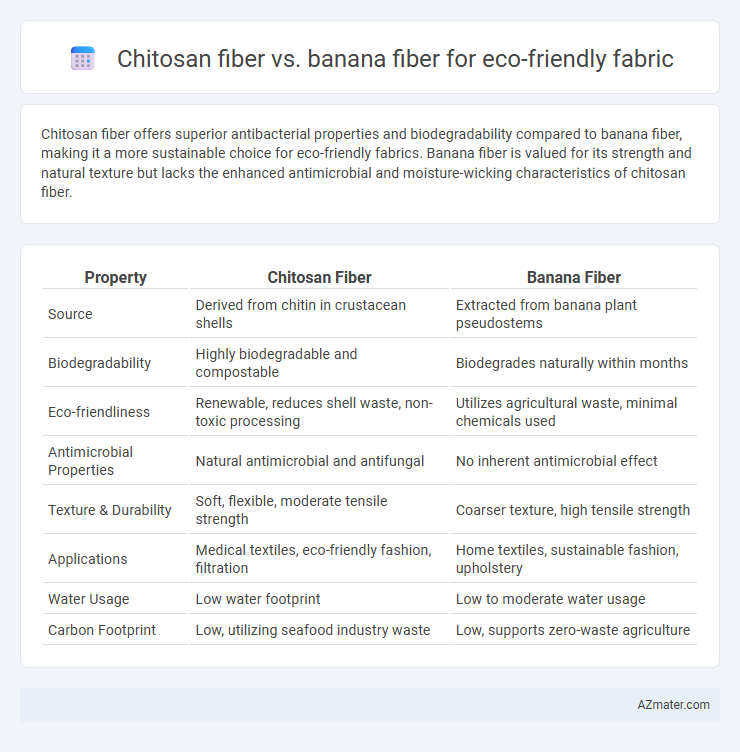Chitosan fiber offers superior antibacterial properties and biodegradability compared to banana fiber, making it a more sustainable choice for eco-friendly fabrics. Banana fiber is valued for its strength and natural texture but lacks the enhanced antimicrobial and moisture-wicking characteristics of chitosan fiber.
Table of Comparison
| Property | Chitosan Fiber | Banana Fiber |
|---|---|---|
| Source | Derived from chitin in crustacean shells | Extracted from banana plant pseudostems |
| Biodegradability | Highly biodegradable and compostable | Biodegrades naturally within months |
| Eco-friendliness | Renewable, reduces shell waste, non-toxic processing | Utilizes agricultural waste, minimal chemicals used |
| Antimicrobial Properties | Natural antimicrobial and antifungal | No inherent antimicrobial effect |
| Texture & Durability | Soft, flexible, moderate tensile strength | Coarser texture, high tensile strength |
| Applications | Medical textiles, eco-friendly fashion, filtration | Home textiles, sustainable fashion, upholstery |
| Water Usage | Low water footprint | Low to moderate water usage |
| Carbon Footprint | Low, utilizing seafood industry waste | Low, supports zero-waste agriculture |
Introduction to Eco-Friendly Fabrics
Eco-friendly fabrics such as chitosan fiber and banana fiber offer sustainable alternatives to conventional textiles by utilizing renewable resources and biodegradability. Chitosan fiber, derived from chitin found in crustacean shells, exhibits antimicrobial properties and enhanced moisture management, making it ideal for medical and activewear applications. Banana fiber, extracted from banana plant stems, provides high tensile strength and natural breathability, supporting eco-conscious fashion through reduced environmental impact and waste utilization.
Overview of Chitosan Fiber
Chitosan fiber, derived from chitin found in crustacean shells, offers exceptional biodegradability and antimicrobial properties, making it a standout option for eco-friendly textiles. Its moisture-wicking ability and natural resistance to bacteria enhance wearer comfort and hygiene, positioning it as a sustainable alternative to conventional fibers. Compared to banana fiber, chitosan fiber combines environmental benefits with functional performance, ideal for applications in activewear and medical textiles.
Overview of Banana Fiber
Banana fiber is a sustainable textile material derived from the pseudostems of banana plants, known for its biodegradability and low environmental impact. This natural fiber exhibits high tensile strength, antimicrobial properties, and excellent breathability, making it suitable for eco-friendly fabric applications. Unlike chitosan fiber, banana fiber is fully plant-based, promoting zero waste by utilizing agricultural byproducts and reducing reliance on synthetic inputs.
Environmental Impact Comparison
Chitosan fiber, derived from crustacean shells, offers significant biodegradability and antimicrobial properties, reducing chemical use in textile processing and minimizing environmental pollution. Banana fiber, extracted from banana plant pseudostems, is a natural, renewable resource that promotes waste valorization by utilizing agricultural byproducts, thus lowering carbon footprint and water consumption compared to conventional fabrics. Both fibers support sustainable textile production, but banana fiber emphasizes circular economy benefits, while chitosan fiber excels in biodegradability and waste-to-resource conversion.
Mechanical Properties and Durability
Chitosan fiber exhibits superior tensile strength and flexibility compared to banana fiber, making it a more durable option for eco-friendly fabrics. Banana fiber, while biodegradable and renewable, tends to have lower mechanical resistance and is more prone to abrasion and wear over time. The enhanced durability and mechanical properties of chitosan fiber contribute to higher longevity and better performance in sustainable textile applications.
Biodegradability and Sustainability
Chitosan fiber, derived from chitin found in crustacean shells, exhibits excellent biodegradability due to its natural origin and antimicrobial properties, making it highly sustainable for eco-friendly fabrics. Banana fiber, extracted from the pseudostem of banana plants, is also biodegradable and supports sustainability by utilizing agricultural waste, reducing environmental impact and promoting circular economy practices. Both fibers offer renewable, compostable alternatives to synthetic textiles, with banana fiber excelling in reducing agricultural byproduct waste and chitosan fiber providing enhanced antimicrobial benefits.
Production Processes and Resources
Chitosan fiber production utilizes chitin derived from crustacean shells, involving deacetylation and spinning into biodegradable fibers through eco-friendly chemical treatments, ensuring minimal environmental impact. Banana fiber is extracted from the pseudostem of banana plants using mechanical decortication and retting processes, leveraging agricultural waste and requiring less water and chemicals compared to conventional fibers. Both fibers promote sustainability, with chitosan emphasizing biowaste valorization from seafood industries and banana fiber focusing on renewable plant-based resources and low-energy processing methods.
Applications in Textile Industry
Chitosan fiber exhibits antimicrobial properties and biodegradability, making it ideal for medical textiles, sportswear, and hygiene products in the eco-friendly fabric market. Banana fiber, derived from agricultural waste, offers high tensile strength and moisture absorbency, suitable for sustainable fashion, upholstery, and home textiles. Both fibers contribute to reducing environmental impact by utilizing renewable resources and promoting circular economy practices in the textile industry.
Cost and Market Availability
Chitosan fiber, derived from crustacean shell waste, tends to have higher production costs due to its complex extraction and processing methods, limiting its current market availability primarily to niche eco-friendly textile sectors. Banana fiber, extracted from the waste of banana plants, offers a more cost-effective alternative with greater scalability and widespread availability in tropical regions where banana cultivation is abundant. Market demand and cost efficiency favor banana fiber adoption for sustainable fabrics, while chitosan fiber remains specialized and less accessible for large-scale eco-friendly production.
Future Prospects and Innovations
Chitosan fiber, known for its antimicrobial properties and biodegradability, shows promising future prospects in sustainable textiles by enhancing fabric functionality and reducing environmental impact. Innovations in banana fiber technology focus on improving fiber extraction methods and blending techniques to increase durability and softness, aligning with circular economy principles. The integration of smart textile applications and eco-friendly treatments in both fibers is expected to drive new market opportunities and accelerate adoption in eco-conscious fashion and technical fabrics.

Infographic: Chitosan fiber vs Banana fiber for Eco-friendly fabric
 azmater.com
azmater.com